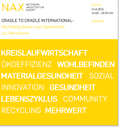Cradle to Cradle-Report
| An article |
by NAX |
In the NAX Report, NAX regularly provides information on political and economic developments, trends and experiences in construction abroad. A current focus is:
Shaping the future with Cradle to Cradle
"The fact that we cannot avoid recycling is not new and is recognised as a necessity in the current climate and sustainability debate. But in the construction of buildings, we often still work as if there were no tomorrow," says Lena Junker, Construction Expert Municipal Development of the Cradle 2 Cradle NGO, at the NAX training webinar "Cradle to Cradle International".
The Cradle to Cradle movement as part of the Circular Economy wants to change this and establish buildings as the material store of the future - with remarkable construction results in the meantime. The Cradle to Cradle (C2C) principle was developed in the 1990s by the German chemist Michael Braungart and the US architect William McDonough. Translated, it means from cradle to cradle and refers to an idealised, closed raw material cycle modelled on nature in which all raw materials of a product remain 100% in the cycle after the period of use and can be reused. Thus, there would no longer be waste, as created by the previous "take - make - waste" model, but only usable recyclable materials.
The Cradle to Cradle principle can be applied to any product. But the reuse of raw materials is particularly important in the building industry. Why? Because up to 50 percent of the world's raw material consumption can be traced back to the building industry. The goal must therefore be to promote C2C in the real-estate and construction industry in order to save raw materials, avoid construction waste and build "recyclable, healthy and valuable buildings" for all future generations that combine innovation, quality and good design.
If one follows the principle, it is about fundamental things: C2C wants to rethink the idea of sustainability, which in the construction sector today is still focused on minimising the ecological footprint or reducing CO2 emissions, in a positive way: a building should be designed in such a way that it not only causes less damage, but also creates added value for people and the environment. Beyond construction materials, this involves three "design principles" in a broader sense: waste as nutrient (resource conservation and continuous material cycles), the use of regenerative energies and the promotion of cultural and biological diversity. These principles allow for a conceivably broad approach to structural sustainability solutions. (...) The idea of C2C is also more of a philosophy, a continuous improvement process, and an invitation to more innovation and responsibility than a fixed concept.
When implementing C2C in the construction sector, numerous factors must be taken into account, because the disposal of construction waste must be oriented towards the two cycles (biological and technical) for the C2C principle. Wood, for example, is part of the biological cycle; metals, glass and steel, on the other hand, are part of the technical cycle. However, this is precisely where hurdles arise in practical implementation: Coatings, additives and adhesive compounds used in the construction of existing buildings make it impossible to separate the individual raw materials.
Does the C2C principle sound complex? Yes, it does, and it is - in particular because humans gravitate towards the "tried and tested" and old thought patterns have to be broken. However, the increasing scarcity of raw materials and the associated rise in raw material prices are forcing us to rethink. (...) Architects could and should use the opportunity offered by C2C as a holistic positivist approach. Actively approaching a builder with this topic and having the project supported by C2C experts could lead to being a pioneer and doing educational work.
The focus is still mainly on Germany, but the internationalisation of C2C is also progressing and can be promoted by planners and C2C-compliant product manufacturers from Germany.
"C2C is not about ideology, but about exploring together what is both feasible and useful."


© Carl Brunn
In HafenCity Hamburg, the Moringa residential high-rise is now the first C2C-inspired residential building in planning. In this purely rental building, circular construction is being tested above all in terms of mass suitability. Jasna Moritz, managing director of the NAX sponsor office kadawittfeldarchitektur, reports on her experiences in building according to the Cradle to Cradle principle and answers questions about the added values, special features, hurdles, costs and opportunities of C2C-based planning.







